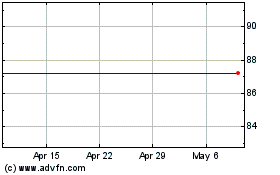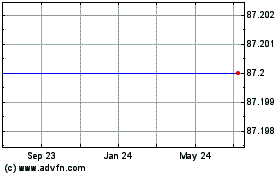Tanker Attacks Lift Oil Prices, Improve Shale Producers' Outlook -- 3rd Update
June 13 2019 - 5:28PM
Dow Jones News
By Ryan Dezember, David Hodari and Sarah McFarlane
Shale producers stand to benefit from the oil-market volatility
unleashed by Thursday's attack on two oil tankers in the Gulf of
Oman, as U.S. companies vie with the Organization of the Petroleum
Exporting Countries for global market share.
The incident near the Strait of Hormuz, through which one-third
of the world's shipped oil passes, highlights the risks associated
with delivering oil from the Persian Gulf. Higher insurance and
shipping costs could crimp margins for oil producers in the region
compared with those in more stable parts of the world, such as the
U.S. and the North Sea.
The attack also calls into question whether the supply forecasts
that have weighed on crude prices recently accurately account for
the potential for geopolitical turmoil. Shares of big shale
producers rose on the news: Cimarex Energy Co. and Parsley Energy
Inc., which drill in West Texas, added 4.2% and 3.1%, respectively.
North Dakota-focused Hess Corp. climbed 2.8%.
"Escalating geopolitical tensions in the Middle East and
dislocations in Venezuela and the brewing cauldron in Libya are
reminders that security of forward supply feels increasingly
fragile," said Bill Herbert, a senior research analyst at Simmons
Energy.
Brent crude, the global benchmark, ended up 2.2% at $61.31 a
barrel on London's ICE Futures exchange. On the New York Mercantile
Exchange, West Texas Intermediate futures climbed 2.2%, to $52.28 a
barrel. Both benchmarks were up twice as much earlier in the
day.
The roughly $9 difference between the international and domestic
benchmarks is largely due to the cost of moving U.S. oil to port
and then on to international markets.
Some investors expect the spread to shrink later this year and
in 2020 when new pipelines open between the prolific Permian Basin
in West Texas with export terminals on the Gulf of Mexico. The new
supply routes, including the 850-mile Gray Oak Pipeline scheduled
to open before year-end, would enable much more U.S. crude to flow
to global markets in direct competition with Middle Eastern
crude.
Selling more oil at prices closer to the international benchmark
would mean more cash in the pockets of domestic producers, which
had a rare moment in the sun thanks to the fiery scenes in the
Middle East. Shares of nearly every U.S. oil concern rose on
Thursday and energy shares in the S&P 500 gained 1.2%, compared
with a 0.4% uptick in the broader stock index. Most U.S. energy
stocks have lost double-digit percentages over the past year, even
as the S&P 500 has risen 4.2%.
Jay Hatfield, portfolio manager for the pipeline-focused
InfraCap MLP exchange-traded fund, said he has been loading up the
ETF with shares of Energy Transfer LP, Plains All American Pipeline
LP and other firms that own or are building infrastructure that
will handle increasing volumes of crude bound for international
markets.
"U.S. production is extremely stable and the rest of the world
is not stable," Mr. Hatfield said. "I'm 100% confident there's
going to be production and delivery issues out of the non-Saudi
OPEC countries."
A U.S. Energy Information Administration report on Thursday
showed that crude imports from OPEC members plunged in March to 1.5
million barrels a day, the lowest level since the same month 1986.
A decade ago, OPEC was supplying the U.S. nearly four times
that.
The tanker attack came amid heightened tensions between the U.S.
and Iran in recent months, with Washington ratcheting up sanctions
on Tehran in early May with the aim of reducing the country's oil
exports to zero. Secretary of State Mike Pompeo said Thursday
afternoon that the Trump administration has concluded that Iran is
responsible for the attacks.
Four vessels in the same region were attacked in May, which
Washington also blamed on Iran. Iran denied involvement. Oil prices
also rallied following those attacks, along with assaults on Saudi
Arabia's East-West pipeline, although analysts said the
geopolitical tensions were offset by concerns about a global
economic slowdown and its impact on oil demand.
Thursday's rally marked a rebound from heavy selling on
Wednesday, which followed the U.S. EIA's reduction of its
oil-demand growth forecasts and bearish inventory data.
The attacks reversed that sentiment, though, and outweighed the
effect of an equally bearish report Thursday from OPEC, which cut
its 2019 forecast for world oil-demand growth.
Spiraling tensions between Middle Eastern oil giants will only
intensify focus on the summit between OPEC and its allies, expected
to take place later this month in Vienna. Producing nations will
come to a decision on whether to extend their continuing output
curbs into the second half of 2019.
Shipowners and insurance firms could raise risk premiums for
their tankers used in the region given the recent attacks.
For now, analysts don't expect any significant change to trade
flows, even if insurance and shipping costs were to rise after the
latest incident, due to the potentially greater costs of finding
substitutes to Middle Eastern oil grades shipped from the
region.
"Unless you see concrete cost implications or disruption risk,
because the alternatives are likely to be more costly or come with
problems in terms of the quality differences, there's quite a high
hurdle for buyers to make changes," said Richard Mallinson, analyst
at consulting firm Energy Aspects.
Write to Ryan Dezember at ryan.dezember@wsj.com, David Hodari at
David.Hodari@dowjones.com and Sarah McFarlane at
sarah.mcfarlane@wsj.com
(END) Dow Jones Newswires
June 13, 2019 17:13 ET (21:13 GMT)
Copyright (c) 2019 Dow Jones & Company, Inc.
Cimarex Energy (NYSE:XEC)
Historical Stock Chart
From Mar 2024 to Apr 2024

Cimarex Energy (NYSE:XEC)
Historical Stock Chart
From Apr 2023 to Apr 2024
